Which dual-band Wi-Fi router to choose for home: review and rating of the TOP 12 best models of 2022
Dual-band router - rating and review of the best models. Key features, specifications, pros and cons of equipment of this type. What to look for when choosing a dual-band router.
dual band routers characterized by high speed, impressive bandwidth, compliance with modern communication standards.
5 GHz routers make it possible to organize a fast and stable Wi-Fi network.
In this review, we will consider the best dual-band network devices, find out what to look for when choosing such a router.
Rating of the TOP 12 best dual-band routers for home
| Place | Model | |
|---|---|---|
| The best models with simultaneous operation on the 2.4 / 5 GHz bands | ||
| #1 | MikroTik hAP ac2 | |
| #2 | Keenetic Giga KN-1010 | |
| #3 | Keenetic Air (KN-1611) | |
| #4 | Xiaomi Redmi Router AC2100 | |
| #5 | ASUS RT-AC58U | |
| #6 | Keenetic Viva (KN-1910) | |
| #7 | TP-LINK Archer C6 | |
| The best models with the possibility of separate operation by ranges | ||
| #1 | Xiaomi Mi WiFi Router 4A | |
| #2 | MikroTik RB4011iGS+5HacQ2HnD-IN | |
| #3 | Xiaomi Mi WiFi Router 4A Gigabit Edition | |
| #4 | Huawei WS7100 | |
| #5 | TP-LINK Archer A9 | |
What is a dual band router?
Dual Band Wi-Fi Router is a network device with the possibility of wireless transmission (distribution) at frequencies of 2.4 and 5 GHz.
Choosing a dual-band router - what to focus on?
- broadcast standard.
The parameter determines the maximum speed of the router.
To date, 802.11n and 802.11ac are the most current standards with the highest maximum data transfer rate. - Antennas.
For rooms up to 100 sq. meters, a router with an external antenna (s) with a gain of more than 5 dBi is suitable.
In the case of a small apartment, an internal antenna up to 5 dBi will suffice. LAN port settings.
The more such connectors, the more devices can be connected via cable.
At the same time, the speed and stability of the connection are the highest in the case of gigabit (1 Gbps) ports.- USB port.
Required for connecting external storage devices, for example, for downloading from torrents.
A number of router models support 3G / 4G modems, which are also connected via a USB interface.
The best models with simultaneous operation on the 2.4 / 5 GHz bands
Simultaneous dual band operation allows you to achieve maximum performance in the ratio of speed / stability of your home or office Wi-Fi network.
Rating of the best dual-band wi-fi models with the ability to simultaneously operate at a frequency of 2.4 and 5 GHz.
MikroTik hAP ac2
The equipment will provide a stable Internet connection for several users at the same time.
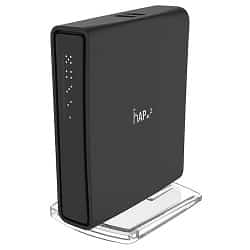
The router supports dual Wi-Fi bands with a maximum transfer rate of 1167 Mbps and the ability to use MIMO multi-stream data transfer technology.
The device is equipped with five gigabit LAN ports, a USB interface with an optional 3G/4G modem connection.
The equipment is controlled via SSH, Telnet protocols, via a web interface.
In addition to the router, the delivery set includes a power supply unit, documentation, mounting mounts.
Technical specifications:
- Wi-Fi frequency bands — 2.4/5 GHz;
- maximum speed - 1167 Mbps;
- support for 802.11 standards - b, a, g, n, ac;
- Internet connection — Ethernet, 3G/4G modem (optional);
- the number of LAN connectors is 5 × 1 Gbps;
- infrastructure support - DHCP/Firewall/NAT/SPI/DDNS/DMZ;
- data encryption - WEP / WPA / WPA2;
- dimensions/weight — 119×34×98 mm, 170 g;
- features - RouterOS OS, Smart Home ecosystem.
Advantages
- excellent functionality;
- wide range of settings;
- connection speed and stability;
- modern look.
Flaws
- small coverage area at 5 GHz;
- dim uninformative indication;
- relatively complex settings.
Keenetic Giga KN-1010
This model in a case made of high-quality composite materials will surprise its owner with high functionality, including support for dual-band signal reception and transmission in a Wi-Fi network.
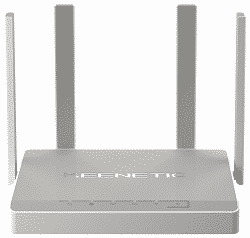
The built-in USB connector provides the ability to use a 3G / 4G modem to connect to the resources of mobile telecom operators.
The network machine is managed and configured via Telnet or a web interface.
Four external fixed antennas boast a significant gain of 5 dBi.
Technical specifications:
- Wi-Fi frequency bands — 2.4/5 GHz;
- maximum speed - 1267 Mbps;
- support for 802.11 standards - b, a, g, n, ac;
- Internet connection — Ethernet, 3G/4G modem (optional);
- the number of LAN connectors is 4 × 1 Gbps;
- infrastructure support - DHCP/Firewall/NAT/SPI/D_DNS/DMZ;
- data encryption - WEP / WPA / WPA2;
- dimensions/weight — 214×33×154 mm, 488 g;
- features - bridge mode, repeater.
Advantages
- simplicity and ease of setup;
- advanced Telnet command interface;
- high quality technical support;
- fast and stable operation;
- seamless transition between Wi-Fi frequencies.
Flaws
- lack of SSH infrastructure;
- not the friendliest web interface;
- the USB ports are in an awkward location on the side.
Keenetic Air (KN-1611)
The presented router belongs to the SOHO class line with the best stability of the Internet connection and support for two Wi-Fi bands - 2.4 and 5 GHz with a maximum speed of 1167 Mbps.
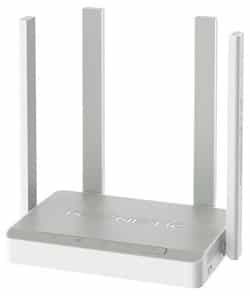
The device is controlled via a web interface or a mobile application.
Setting up the router is extremely simple and is designed, among other things, for not the most experienced users.
Also, the model provides the possibility of a wired connection via the WAN interface. The speed will be up to 100 Mbps.
Technical specifications:
- Wi-Fi frequency bands — 2.4/5 GHz;
- maximum speed - 1167 Mbps;
- support for 802.11 standards - b, a, g, n, ac;
- connection to the Internet — Ethernet;
- the number of LAN connectors is 4×100 Mbps;
- infrastructure support - DHCP/Firewall/NAT/SPI/D_DNS/DMZ;
- data encryption - WEP / WPA / WPA2;
- dimensions/weight — 159×29×110 mm, 248 g;
- features - guest network, Telnet, Smart Home ecosystem.
Advantages
- convenience of the mobile application;
- extended wireless network coverage;
- speed limit option for guest devices;
- high build quality and materials.
Flaws
- only 100 MB over cable;
- not the most responsive web interface;
- sometimes channels change for no apparent reason.
Xiaomi Redmi Router AC2100
Provides users with a stable and powerful wireless connection regardless of the presence of obstacles, whether it be furniture or concrete walls.
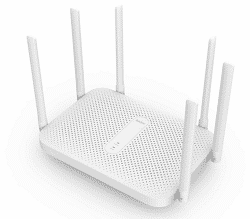
Built-in 128 Mbyte of memory ensure stable operation of the device with a significant number of connected devices.
Remote configuration and control of the device is carried out through a mobile application.
The device's broadly directional antennas boast a high gain of 5 dbi.
Technical specifications:
- Wi-Fi frequency bands — 2.4/5 GHz;
- maximum speed - 2033 Mbps;
- support for 802.11 standards - b, a, g, n, ac;
- connection to the Internet — Ethernet;
- the number of LAN connectors is 3 × 1 Gbps;
- Wi-Fi standard - b, a, g, n, ac;
- infrastructure support - DHCP/Firewall/NAT;
- data encryption - WEP / WPA / WPA2;
- dimensions/weight — 259×184×176 mm, 475 g;
- features - 128 Mbyte memory.
Advantages
- impressive wireless coverage area;
- possibility of wall mounting is provided;
- high speed of receiving and transmitting data;
- nice modern look.
Flaws
- short Ethernet cable;
- big sizes;
- no WPS button.
ASUS RT-AC58U
A router with optional support for 3G and 4G standards will become a key element of a wireless network in a house, apartment or office, providing users with a reliable Internet connection.
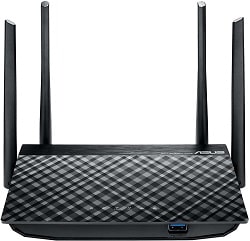
There are also four high-speed gigabit LAN ports, a WAN connection interface, a USB connector for reading and writing from external media, charging and connecting a 3G / 4G modem on board.
At the same time, the device is relatively compact and does not stand out with significant weight.
Technical specifications:
- Wi-Fi frequency bands — 2.4/5 GHz;
- maximum speed - 1267 Mbps;
- support for 802.11 standards - b, a, g, n, ac;
- Internet connection — Ethernet, 3G/4G modem (optional);
- the number of LAN connectors is 4 × 1 Gbps;
- infrastructure support - DHCP/Firewall/NAT/SPI/D_DNS/DMZ;
- data encryption - WEP / WPA / WPA2;
- dimensions/weight — 207×149×36 mm, 395 g;
- features - file / print server, FTP.
Advantages
- productive hardware;
- minimalistic design, compactness;
- the ability to completely turn off the indication;
- high-speed LAN ports;
- stability under high loads (for example, when downloading torrents).
Flaws
- relatively complex settings;
- there are no activity LEDs for each individual LAN port;
- takes a long time to reboot;
- short bundled cable for connecting to the Internet.
Keenetic Viva (KN-1910)
A dual-band gigabit network machine equipped with an MTK processor and the ability to use 3G and 4G modems.
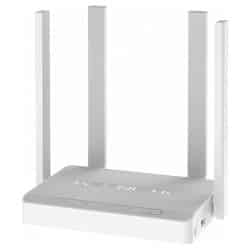
Built-in USB connectors provide the ability to operate the equipment as a file, DLNA or print server.
The device supports Wi-Fi bands at 2.4 and 5 GHz frequencies with a maximum bandwidth of 1267 Mbps.
A set of WEP, WPA and WPA2 protocols is responsible for connection security.
Four external fixed antennas stand out with a high gain of 5 dBi.
Technical specifications:
- Wi-Fi frequency bands — 2.4/5 GHz;
- maximum speed - 1267 Mbps;
- support for 802.11 standards - b, a, g, n, ac;
- Internet connection — Ethernet, 3G/4G modem (optional);
- the number of LAN connectors is 4 × 1 Gbps;
- infrastructure support - DHCP/Firewall/NAT/SPI/D_DNS/DMZ;
- data encryption - WEP / WPA / WPA2;
- dimensions/weight — 159×29×110 mm, 270 g;
- features - bridge, repeater modes.
Advantages
- high speed Wi-Fi signal;
- good transmitter power;
- dynamic channel selection;
- a number of functions for advanced;
- interesting design.
Flaws
- decent price tag;
- no indicator of local network activity;
- fairly large antennas.
TP-LINK Archer C6
The model is adapted for use in a house, apartment or small office for wired and wireless connection of client equipment to Internet resources.

The device supports the most common and current Wi-Fi standards with simultaneous operation on two frequencies.
The range of the equipment is provided by four external fixed antennas.
To manage and configure the router, a web interface or an intuitive application for mobile gadgets can be used.
Technical specifications:
- Wi-Fi frequency bands — 2.4/5 GHz;
- maximum speed - 1167 Mbps;
- support for 802.11 standards - b, a, g, n, ac;
- connection to the Internet — Ethernet;
- the number of LAN connectors is 4 × 1 Gbps;
- infrastructure support - DHCP/Firewall/NAT/SPI/D_DNS/DMZ;
- data encryption - WEP / WPA / WPA2;
- dimensions/weight — 230×35×144 mm, 500 g;
- features - guest network, MIM support.
Advantages
- many settings are saved without reboot;
- simultaneous operation on two Wi-Fi bands;
- convenient and understandable software environment for the phone;
- the ability to update the firmware via the Internet;
- switchable LED indication;
- option to block dangerous resources.
Flaws
- long boot/restart;
- not the most powerful Wi-Fi at 5 GHz;
- cumbersome web-interface;
- there is no way to roll back the firmware.
The best models with the possibility of separate operation by ranges
The best models with such an opportunity will be considered further.
Xiaomi Mi WiFi Router 4A
The presented model has four non-detachable broadband antennas to provide a stable and fast dual-band Wi-Fi connection for stationary and portable devices.
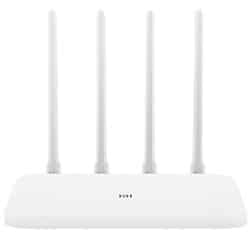
For wired data transfer, the device has a pair of LAN ports. You can set up a working configuration via the Web interface.
Technical specifications:
- Wi-Fi frequency bands — 2.4/5 GHz;
- maximum speed - 1167 Mbps;
- support for 802.11 standards - b, a, g, n, ac;
- connection to the Internet — Ethernet;
- number of LAN connectors - 2 × 100 Mbps;
- infrastructure support - DHCP/Firewall/NAT;
- data encryption - WEP / WPA / WPA2;
- dimensions/weight — 188×25×101 mm, 380 g;
- features - Chinese plug, Smart Home ecosystem.
Advantages
- simple installation and configuration;
- stable signal at both frequencies;
- attractive appearance;
- democratic pricing.
Flaws
- no IPTV support;
- few LAN ports;
- no wall mounting provided.
MikroTik RB4011iGS+5HacQ2HnD-IN
The dual-band professional router supports simultaneous operation at frequencies of 2.4 and 5 GHz and, when connected to the Internet, allows you to achieve Wi-Fi distribution speeds up to 2033 Mbps.
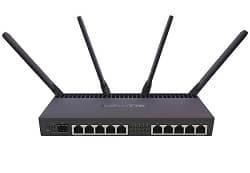
The device operates under the RouterOS operating system, it is equipped with a powerful transmitter and four external antennas with a gain of at least 3 dbi.
The device provides a wide coverage area and a stable wireless connection signal.
An interesting feature of the device is a set of ten gigabit LAN ports for high-speed wired connection of client PCs to the network.
Technical specifications:
- Wi-Fi frequency bands — 2.4/5 GHz;
- maximum speed - 2033 Mbps;
- support for 802.11 standards - b, a, g, n, ac;
- connection to the Internet — Ethernet;
- the number of LAN connectors is 10 × 1 Gbps;
- infrastructure support - DHCP/Firewall/NAT/SPI/D_DNS/DMZ;
- data encryption - WEP / WPA / WPA2;
- dimensions/weight — 228×30×120 mm, 1000 g;
- features - RAM 1024 Mbyte, bridge mode, console port.
Advantages
- flexible settings;
- powerful transmitter;
- productive processor;
- a huge amount (for a router) of RAM;
- Convenient to use both at home and in the office.
Flaws
- strong heating during operation;
- lack of a USB port;
- no support for LTE modems.
Xiaomi Mi WiFi Router 4A Gigabit Edition
dual band router Xiaomi It is designed for simultaneous transmission and reception of data at frequencies of 2.4 and 5 GHz, which allows you to provide any supported device with a wireless connection speed of 1167 Mbps.

The WEP, WPA, WPA2 protocols are responsible for protecting the connection.
Gigabit WAN and LAN interfaces guarantee wired Internet from the provider's network to stationary PCs.
Management, configuration and optimization of equipment is carried out through a web interface or a proprietary application for tablets and phones.
Technical specifications:
- Wi-Fi frequency bands — 2.4/5 GHz;
- maximum speed - 1167 Mbps;
- support for 802.11 standards - b, a, g, n, ac;
- connection to the Internet — Ethernet;
- the number of LAN connectors is 2 × 1 Gbps;
- infrastructure support - DHCP/Firewall/NAT;
- data encryption - WEP / WPA / WPA2;
- dimensions/weight — 201×25×122 mm, 228 g;
- features - Chinese plug, Smart Home ecosystem.
Advantages
- convenient mobile application translated into Russian;
- excellent transmission and reception performance;
- not bright LED indicators;
- compactness, low weight.
Flaws
- wall mounts are not implemented;
- few LAN ports;
- narrow wireless signal pattern.
Huawei WS7100
Model from Huawei in an unusually shaped case, it has outstanding technical parameters, including support for two Wi-Fi bands with a maximum channel speed of up to 2976 Mbps.

The 2.4 and 5 GHz bands can be used both simultaneously and each separately.
The device is controlled via a web interface. Basic settings will not cause difficulties even in the absence of experience with network equipment.
The device is connected to the power supply via a compact adapter, the device is designed for indoor use.
Technical specifications:
- Wi-Fi frequency bands — 2.4/5 GHz;
- maximum speed - 2976 Mbps;
- support for 802.11-ax standards;
- connection to the Internet — Ethernet;
- the number of LAN connectors is 3 × 1 Gbps;
- infrastructure support - DHCP/Firewall/NAT/D_DNS/DMZ;
- data encryption - WEP/WPA/WPA2/WPA3;
- dimensions/weight — 159×40×225 mm, 390 g;
- features - support for IPTV, MIM.
Advantages
- affordable price tag;
- simple setup;
- high wire speed;
- Wi-Fi module of the sixth version;
- switchable dual-band broadcasting;
- backup access point for legacy equipment.
- Advantage;
Flaws
- low wireless signal strength;
- there is no possibility of mounting on the wall.
- Flaw;
TP-LINK Archer A9
A dual-band high-performance network device from TP-Link with the ability to connect a 3G / 4G modem will allow you to organize fast access to the Internet for a large number of users.
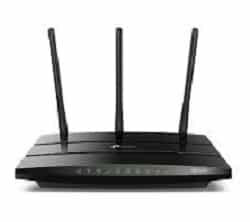
Functioning in two wireless networks on the 2.4 and 5 GHz bands with a maximum data transfer rate of 1900 Mbps and gigabit LAN ports make this network machine suitable for universal use.
A convenient display panel will allow you to monitor the progress of the device.
Technical specifications:
- Wi-Fi frequency bands — 2.4/5 GHz;
- maximum speed - 1900 Mbps;
- support for 802.11 standards - b, a, g, n, ac;
- Internet connection — Ethernet, 3G/4G modem (optional);
- the number of LAN connectors is 4 × 1 Gbps;
- infrastructure support - DHCP/Firewall/NAT/SPI/D_DNS/DMZ;
- data encryption - WEP / WPA / WPA2;
- dimensions/weight — 244×187×33 mm, 600 g;
- features - FTP, MIM support, file server, Smart Home ecosystem.
Advantages
- stable, high-speed connection;
- large Wi-Fi coverage area;
- no disconnections (including through VPN);
- the most advanced options and technical solutions.
Flaws
- the analyzer of DDOS attacks does not work correctly;
- logs are not saved after shutdown/restart;
- relatively high price tag.
Reviews
This review has no replies yet.
Conclusion
- Dual band routers are characterized options such as high speed, excellent bandwidth, the most modern communication standards.
- Routers supporting dual Wi-Fi ranges refer to network equipment that supports the operation of a wireless module at 2.4 GHz and 5 GHz frequencies.
- When choosing such a device you should pay attention to broadcasting standards, antenna parameters, the number and speed of LAN connectors, and the presence of a USB port.
- Models with simultaneous operation on the 2.4/5 GHz bands provide maximum performance in terms of speed and stability home or office network.
- Models with separate operation at these frequencies can be useful when congested with Wi-Fi networks space in an apartment building or office.
Useful video
From this video you will learn which Wi-Fi router is better to choose - 2.4 GHz VS 5 GHz:


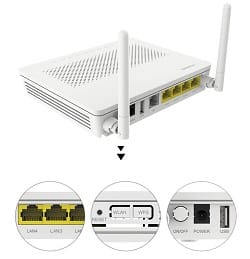 LAN port settings.
LAN port settings.